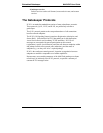
MultiVOIP User Guide Embedded Gatekeeper
481
Gatekeeper Basics
Introduction
Gatekeepers are optional within H.323 networks. However, when they are
present, gateways (voip units) and other network endpoint devices (like
terminals and Multipoint Control Units used in conferences) must use
gatekeeper services. There are four functions that H.323 gatekeepers must
provide to the network and many other functions, both standard and
proprietary, that the gatekeeper may offer to network participants.
Mandatory Gatekeeper Functions
The mandatory gatekeeper functions are address translation, admission control,
bandwidth control, and zone management.
Address Translation
The gatekeeper supports aliases, such as conventional E.164 phone numbers,
for each endpoint registered within the zone. Users call each other within a
zone by simply dialing a number or string of characters instead of an IP
address. This function is particularly important when a phone on the circuit-
switched network tries to call a phone connected to a gateway on an IP
network.
Admission Control
The gatekeeper determines which network participants can and cannot make
calls, according to established network permissions and rules. The gatekeeper
controls admission using H.225 “RAS” messages (Registration, Admission,
Status).
Bandwidth Control
With the MultiVOIP Gatekeeper, the network administrator can specify
bandwidth limitations within a gatekeeper’s zone and can specify a bandwidth
limit for gateway endpoints. The gatekeeper controls bandwidth using H.225
RAS messages. A gatekeeper may determine there is no bandwidth available
for a call or no additional bandwidth available for an ongoing call requesting
an increase. Dynamic (situation-dependent) changes in bandwidth allocation
are typically called “bandwidth management,” which is considered an optional
gatekeeper function.


















